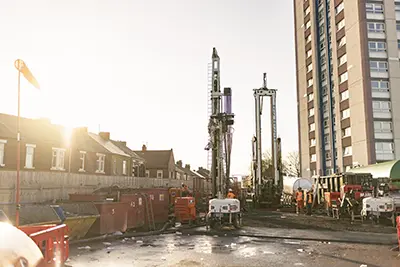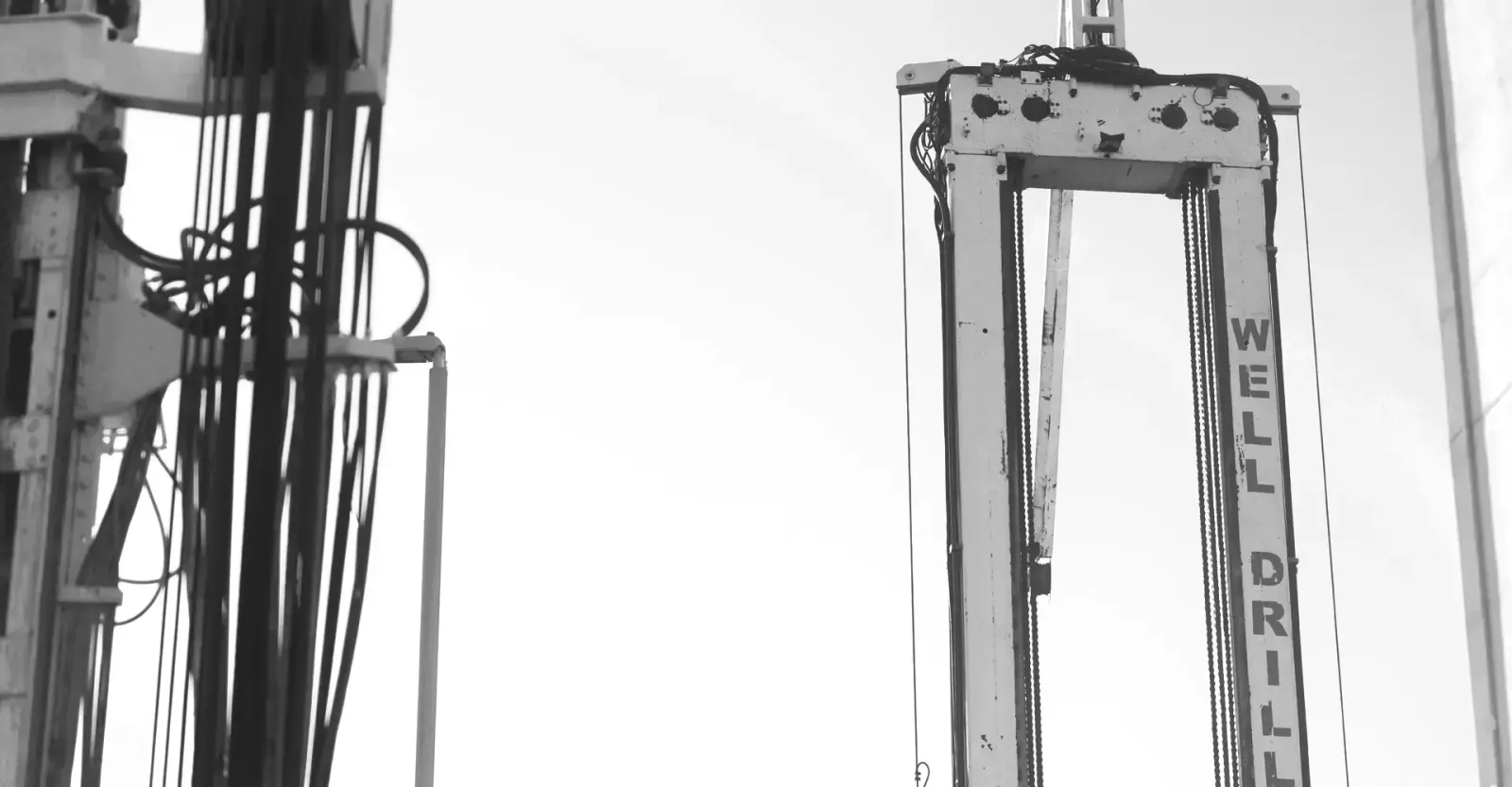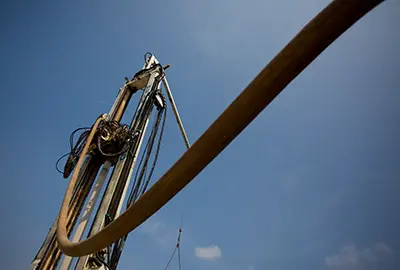

Closed Loop Geothermal Drilling
Closed loop geothermal systems use a network of pipes buried underground to extract or reject heat, depending on the season.
About
Closed Loop Geothermal Boreholes
Unlike open loop systems, closed loop systems do not require access to groundwater or aquifers.
Instead, a heat transfer fluid is circulated through the pipes in sealed circuits to exchange energy with the earth.
At Igne, we design and drill closed loop geothermal boreholes that deliver lasting performance, reliability and environmental benefits.
Whether you’re developing a new building, upgrading your energy systems or retrofitting for net zero, our specialist drilling teams provide the expertise and capability to support your project across the UK.
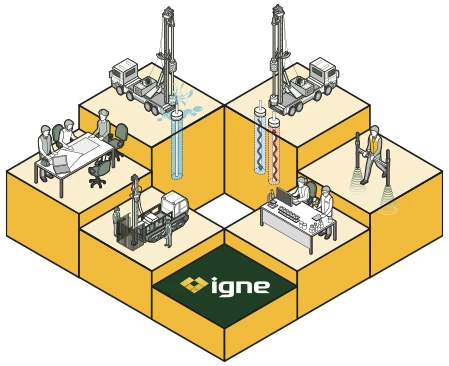
The explanation
What is Geothermal Energy & How Does a Closed Loop System Work?
Geothermal energy is the heat that comes from within the Earth. It is a renewable resource that remains consistent all year round, unaffected by air temperature, wind or sunlight.
In closed loop systems, this heat is absorbed by a fluid circulating through underground pipe loops and delivered to a ground source heat pump, which then raises it to a usable temperature for heating or hot water.
In summer, the system can work in reverse, rejecting excess indoor heat into the cooler ground, an efficient, low-energy way to provide cooling for buildings or data centres.
The Process
How are geothermal boreholes drilled for closed loop systems?
Closed loop systems can be installed horizontally or vertically. Igne specialises in vertical closed loop borehole drilling, which is ideal where land area is limited or where thermal efficiency must be maximised.
A vertical closed loop borehole typically ranges from 50 to 200+ metres in depth. Each borehole contains a U-shaped pipe (commonly made from HDPE) through which a heat transfer fluid is pumped.
Once drilled and looped, the borehole is backfilled with thermally enhanced grout to promote efficient heat transfer and ensure long-term system integrity.
Igne provides:
- Thermogeological assessments to model heat transfer
- High-precision vertical drilling using specialist rigs
- Loop pipe installation and grouting
- Pressure testing and commissioning
- Support for designers and heat pump manufacturers
We ensure that each system is matched to the building’s energy demand, the ground conditions, and the available space on site.
The application
Where are Closed Loop Systems Best Used?
Closed loop geothermal systems are extremely flexible and well-suited to:
• Schools, universities and public buildings
• Residential developments and housing estates
• Heritage sites or listed buildings (where surface disturbance must be minimised)
• Commercial properties with consistent year-round energy demand
• Buildings without access to a high-yield aquifer
They are especially effective where long-term, low-carbon performance is a key driver.
The benefits
The benefits of Closed Loop Geothermal Systems
Closed loop systems offer some significant advantages:
- No need for water abstraction licences
- Suitable for areas with low or variable groundwater availability
- Minimal maintenance once installed
- No environmental discharge or reinjection needed
- Consistent performance over decades
- Compatible with most UK geology
Igne’s vertical drilling approach ensures these benefits are delivered with maximum efficiency and minimal disruption.
The analysis
Comparing Closed Loop & Open Loop Systems
While both closed and open loop systems offer renewable heating and cooling, there are key differences:
Open Loop Systems:
- Use groundwater directly for heat exchange
- Require separate abstraction and reinjection boreholes
- More efficient in high-yield aquifers
- Need environmental permitting
- Can support large-scale heating loads
Closed Loop Systems:
- Use sealed pipe circuits; no groundwater involved
- Do not require licences or discharge consents
- Simpler to install in many settings
- Less sensitive to water chemistry or seasonal flow variations
Igne has the expertise to advise on the most appropriate system for your site. In many cases, closed loop systems offer a more straightforward and scalable solution, especially when vertical drilling is an option.
Ground Source Heat Pumps
Ground Source Heat Pumps & System Efficiency
Ground source heat pumps (GSHPs) are a critical component of any closed loop system. They work by raising the temperature of the low-grade heat collected by the circulating fluid, making it suitable for underfloor heating, radiators or domestic hot water.
Because ground temperatures remain stable at depth (typically around 10–14°C in the UK), GSHPs can operate far more efficiently than air source heat pumps, especially during colder months.
Igne works closely with GSHP designers and suppliers to ensure that borehole field layout, depth, loop configuration and system pressure all align with the heat pump specification.
The advantages
Environmental Performance & Long-Term Returns
Closed loop geothermal systems are among the cleanest and most sustainable building energy options available. They use no combustion, produce no on-site emissions, and have very low operating costs over time.
Igne ensures that all systems are designed for thermal balance, meaning the amount of heat extracted and rejected over the year remains stable, preserving long-term performance and ground temperature stability.
Our vertically drilled systems:
- Reduce carbon emissions significantly
- Minimise site disturbance
- Require little to no ongoing maintenance
- Provide 25+ years of system life with low lifecycle cost
FAQ
Frequently Asked Questions about Closed Loop Geothermal Drilling
- How deep do closed loop boreholes need to be?
Depths vary depending on ground conditions and building demand. Typical depths are between 100 and 150 metres.
- Can multiple boreholes be installed on one site?
Yes. Borehole fields can include multiple loops spaced a few metres apart to meet higher thermal demands.
- Is planning permission required for closed loop geothermal?
In most cases, no planning permission is needed, but deeper installations may require consultation with local authorities or the Environment Agency.
- Is the system safe for groundwater?
Yes. Closed loop systems are sealed and isolated from the groundwater, with thermally conductive grout providing additional protection.
- How long does installation take?
Each borehole can be drilled and looped within 1 to 2 days. Total system installation depends on the number of boreholes and access conditions.
- Why choose Igne for closed loop geothermal drilling?
When it comes to installing closed loop systems, precision matters. Igne combines deep technical knowledge of geology, drilling methods, and thermodynamics to deliver geothermal boreholes that perform from day one.
The next step
Call the Geothermal Experts
We work alongside consultants, M&E contractors, architects and developers to ensure your project runs smoothly, safely and sustainably. With nationwide reach and specialist rigs for a wide range of access conditions, we deliver vertical loop systems that meet the highest standards in quality and reliability.
At Igne, we go beyond just drilling holes. We deliver closed loop geothermal systems that unlock lasting environmental and financial benefits. Whether you’re targeting carbon reduction, planning a renewable retrofit or developing from the ground up, Igne will help you drill deep for dependable performance.
Contact us today to talk through your site’s potential

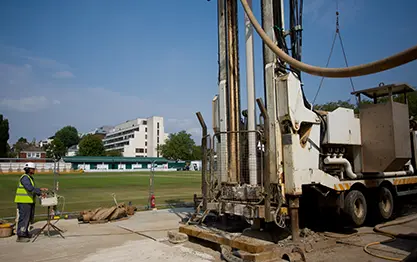
Open Loop Geothermal Drilling
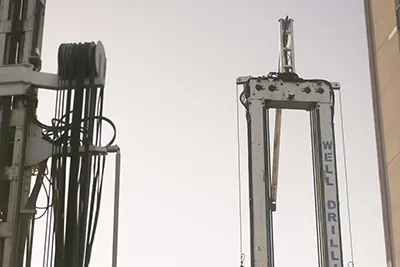
Closed Loop Geothermal Drilling
